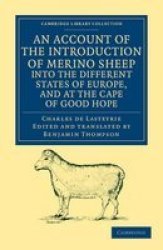Description
This book is about the introduction of Merino sheep into different parts of Europe and the Cape of Good Hope. It describes the qualities of Merino sheep and their adaptability. It was originally published in French in 1802 and was translated into English in 1810 by Benjamin Thompson.
During the eighteenth century, Spain relaxed its stringent export restrictions on Merino sheep, whose notably fine fleeces had long ensured the reputation of the Spanish woollen industry. Merinos were introduced around Europe and in 1792 Sir Joseph Banks, President of the Royal Society, established the first British flock in George III's gardens at Kew. This book, describing the qualities and adaptability of the Merino, was originally published in Paris in 1802 by the French agriculturalist and aristocrat C. P. Lasteyrie (1759-1849). It appeared in 1810 in this English translation by Benjamin Thompson (1775/6-1816), a professional playwright and translator, who was also an unsuccessful agricultural speculator and, briefly, secretary to the Merino Society. Documenting the spread of the Merino, regional variations in breeding regulations and husbandry practices, and wool yields, prices and taxation, this promotional treatise sheds light on the history of both agriculture and commodity trading.
